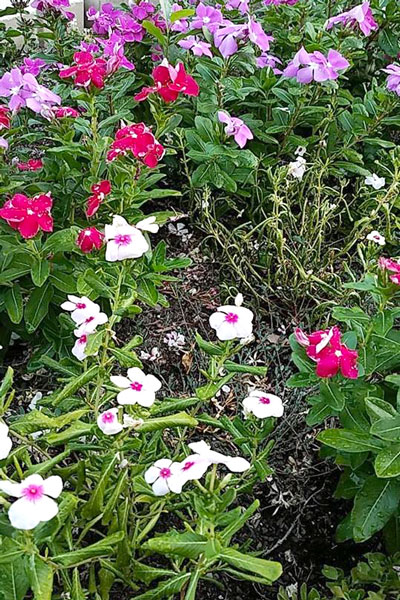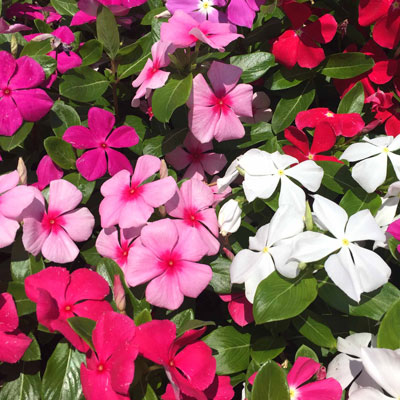Question of the Week Number 2: July 5, 2018
“Neil, what has happened to my periwinkles? They are dying in just a few days.”

This bed of periwinkles has been going downhill for a couple of weeks. Sadly, I’m not sure if any of it can be saved.
Big name, big problem…
This is Phytophthora, and it spells big trouble for periwinkles. It’s in a group of diseases known as water mold funguses. They exist on the surface of the soil and they splatter up and onto stems and leaves when we water and during heavy rains.
The others are Rhizoctonia and Pythium, commonly called together “damping off” when they attack young seedlings.
Phytophthora shows up on periwinkles looking like you pressed a hot paring knife flat against the stems. There is a sunken gray lesion, and all of the growth above that lesion wilts and quickly turns brown. Soon more lesions appear and before you know it the entire plant is lost. It spreads to adjacent plants and the bed is lost. Sadly, the disease is left in the soil to infect subsequent crops in following years.
Things you can do to lessen the chances…
• Avoid plants known to be susceptible to water mold funguses. Most likely candidates in my experience include periwinkles, petunias, pansies, snapdragons and mums. If you have a bed that’s had Phytophthora once, avoid planting these for years into the future.
• Plant in perfectly draining soils, preferably in raised beds. Planting in large decorative pots in fresh potting soil is the best possible option. Then you have to hope that the plants you buy aren’t infected when you buy them. (Don’t blame the nurseryman. This disease is everywhere.)
• Wait to plant periwinkles until it’s really hot (mid-June or later). Early plantings are far more vulnerable because of cool temperatures and spring rains.

These are ‘Cora’ periwinkles. Beautiful, aren’t they? These were bred for resistance to Phytophthora water mold fungus, and in this planting they’re holding up wonderfully. Unfortunately, the photo of the diseased periwinkles above is also of Coras. However, they were planted in mid-April (way too early).
• Choose a variety that’s been bred for resistance to the disease. Cora periwinkles are such a type, but even they will succumb under certain conditions.
• Keep stems and foliage dry whenever you can. Avoid splashing water as much as you can. Mulching the ground will help.
• Rotate your crops so you don’t plant susceptible types of plants year after year in the same soil. Do this even if you don’t see Phytophthora in your plantings. You just don’t want to take the chance.
